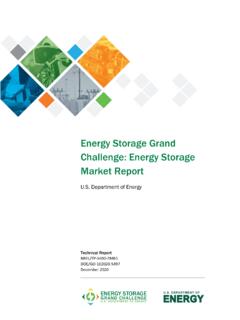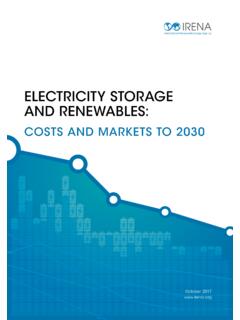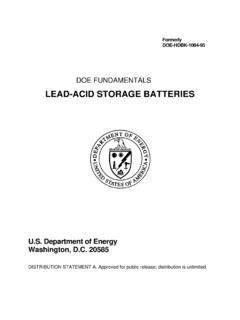Transcription of Electricity Storage Technology Review - Energy
1 Electricity Storage Technology Review Prepared for Department of Energy Office of Fossil Energy June 30, 2020 Executive Summary Electricity Storage Technology Review i Contents Executive Summary .. 1 Introduction .. 1 Project Overview and Methodology .. 1 Worldwide Electricity Storage Installations .. 2 The Issue at Hand: Large Market Penetration of Intermittent Electricity Generation Capacity .. 4 Services Provided by Energy Storage Systems .. 5 Indirect Benefits: Grid-Connected Services Provided by Energy Storage .. 5 Direct Benefits: Integrating Energy Storage Directly with Generation .. 6 Opportunities for Fossil Thermal Integration with Storage .. 6 Technology Reviews .. 8 stationary Battery Energy Storage .. 9 Lithium-Ion BES .. 9 Redox Flow BES .. 14 Other BES .. 19 Mechanical Energy 22 Compressed Air Energy Storage (CAES) .. 22 Pumped Storage Hydropower (PSH) .. 24 Thermal Energy Storage .
2 27 Super Critical CO2 Energy Storage (SC-CCES) .. 27 Molten Salt .. 29 Liquid Air .. 31 Chemical Energy Storage .. 33 Hydrogen .. 34 Ammonia .. 38 Methanol .. 40 Conclusions and Recommendations .. 43 Bibliography .. 49 Executive Summary Electricity Storage Technology Review ii Table of Figures Figure 1. Comparative Matrix with Preliminary Assessment of Energy Storage Technologies .. 2 Figure 2. Worldwide Electricity Storage Operating Capacity by Technology and by Country, 2020 .. 2 Figure 3. Worldwide Storage Capacity Additions, 2010 to 2020 .. 3 Figure 4. Illustrative Example of the Impact of PV Deployment on Generator Dispatch .. 4 Figure 5. Overview of Range of Services That Can Be Provided by Energy Storage Systems .. 5 Figure 6. Co-Locating Vs. Standalone Energy Storage at Fossil Thermal Powerplants Can Provide Net Benefits Depending on Ancillary Electric Market Structure .. 7 Figure 7.
3 Illustrative Configuration of a stationary Lithium-Ion BES .. 9 Figure 8. Summary Operating Characteristics of Lithium-Ion BES .. 11 Figure 9. Example Lithium-Ion BES Cost Projections Illustrating Capacity and Energy Considerations, $ 13 Figure 10. Evolution of Electric Vehicle BES Cost Projections Illustrate the Effects of Ongoing Technological Change, $/kWh .. 13 Figure 11. Example Configuration of a Vanadium Redox-Flow BES .. 14 Figure 12. Summary Operating Characteristics of Flow BES .. 15 Figure 13. Companies Active in Flow BES Commercialization 16 Figure 14 Illustrative Cost Projections for Flow BES at Different Hour Ratings, $/kW .. 18 Figure 15. Large-Scale BES Power Capacity and Energy Capacity by Chemistry, 2003-2017 .. 19 Figure 16. Illustrative Comparative Costs for Different BES Technologies by Major Component .. 21 Figure 17. Diagram of A Compressed Air Energy Storage System.
4 22 Figure 18. Diagram of A Pumped Storage Hydropower Station .. 24 Figure 19. Diagram of Super Critical CO2 Energy Storage System .. 27 Figure 20. Molten Salt Energy Storage Principle of Operation .. 29 Figure 21. Illustrative Integration of Thermal Energy Storage into Powerplant .. 29 Figure 22. Liquid Air Power Cycle .. 31 Figure 23. Universal Block Flow Diagram Illustrating a Multitude of Opportunities for Fossil Thermal Powerplant Systems to be Integrated with Chemical Energy Storage .. 33 Figure 24. Efficiencies of Fuel Cells at Different Chemistries and Temperatures .. 35 Figure 25. Comparative Assessment of Energy Storage Technologies .. 43 Figure 26. Hourly Coal Powerplant Efficiency by Load Level for a Representative Region in 2013 - 2015 45 Figure 27. Fossil Thermal Powerplant Characteristics .. 46 Figure 28. Getting It Right in Economic Unit Commitment and Dispatch is Key.
5 47 Figure 29. Modeling Issues .. 48 Note about the Review : The Review is intended to provide a briefing regarding a range of Energy Storage technologies that includes a detailed listing of primary sources. For that reason, Microsoft Word, rather than PowerPoint, was used for producing the Review . Executive Summary Electricity Storage Technology Review 1 Executive Summary Objective: o The objective is to identify and describe the salient characteristics of a range of Energy Storage technologies that currently are, or could be, undergoing R&D that could directly or indirectly benefit fossil thermal Energy power systems. o The uses for this work include: Inform DOE-FE of range of technologies and potential R&D. Perform initial steps for scoping the work required to analyze and model the benefits that could arise from Energy Storage R&D and deployment. Technology Benefits: o There are potentially two major categories of benefits from Energy Storage technologies for fossil thermal Energy power systems, direct and indirect.
6 Grid-connected Energy Storage provides indirect benefits through regional load shaping, thereby improving wholesale power pricing, increasing fossil thermal generation and utilization, reducing cycling, and improving plant efficiency. Co-located Energy Storage has the potential to provide direct benefits arising from integrating that Technology with one or more aspects of fossil thermal power systems to improve plant economics, reduce cycling, and minimize overall system costs. Preliminary Findings: o Energy Storage technologies with the most potential to provide significant benefits with additional R&D and demonstration include: Liquid Air: This Technology utilizes proven Technology , Has the ability to integrate with thermal plants through the use of steam-driven compressors and heat integration, and Limits stored media requirements. Of the two most promising technologies, this is the one most ready for immediate deployment.
7 Ammonia Production with Cracking and a Hydrogen Fuel Cell: For thermal integration, this Technology is very close to immediate deployment, Eliminates the need for costly cryo- Storage of hydrogen, and It offers the opportunity for heat integration and Technology adoption as hydrogen electrolysis and fuel cell Technology is advanced. Executive Summary Electricity Storage Technology Review 2 Figure 1. Comparative Matrix with Preliminary Assessment of Energy Storage Technologies Benefits Technology Maturity (Experience) Durability/ Reliability (Degradation) Duration Capacity (hours) Dispatch Capacity (MW) Response Time Relative Cost Fossil Themal Integration (Opportunity) Better ( ) High Limited High High Faster Low High Worse ( ) Limited High Low Low Slower High Limited stationary Battery Energy Storage Li-Ion BES Redox Flow BES Mechanical Energy Storage Compressed Air niche1 Pumped Hydro niche1 Thermal Energy Storage SC-CCES Molten Salt2 Liquid Air Chemical Energy Storage3 Hydrogen (H2) 4 5 Ammonia (NH3) 4 Methanol (MeOH) Source: OnLocation Notes.
8 (1) Compressed Air and Pumped Hydro utilize specific geological formations which are not readily available to all facility locations. (2) Molten Salt is expanded to include several thermal Storage media as the complexity of a high-temperature fluid, as opposed to a stationary /solid media, appears to hold little additional benefit for fossil thermal application. (3) Chemical Energy Storage consists of several different options, as described in the report. (4) While conventional hydrogen and ammonia production processes are mature, this report considers newer technologies that are more directly applicable to fossil thermal integration. (5) Conventional hydrogen Storage is relatively mature, however geologic Storage is being explored and is similar to Compressed Air Storage in Technology maturity. o Other promising technologies include: Super Critical CO2 Energy Storage (SC-CCES) Methanol with Hydrogen Fuel Cell o Specific enabling technologies that may benefit from additional R&D include: Electrolysis (generally), Direct Methanol Fuel Cell (DMFC), and High-Temperature Steam Electrolysis (HTSE) that couples 800 C steam with solid-oxide electrolysis to reduce the Electricity requirement o Energy Storage technologies that are largely mature but appear to have a niche market, limited application, or R&D upside include: Pumped hydro Storage Compressed Air Energy Storage (CAES) Executive Summary Electricity Storage Technology Review 3 o Energy Storage technologies are undergoing advancement due to significant investments in R&D and commercial applications.
9 O There exist a number of cost comparison sources for Energy Storage technologies For example, work performed for Pacific Northwest National Laboratory provides cost and performance characteristics for several different battery Energy Storage (BES) technologies (Mongird et al. 2019). Recommendations: o Perform analysis of historical fossil thermal powerplant dispatch to identify conditions for lowered dispatch that may benefit from Electricity Storage . o Improve techno-economic modeling tools to better account for the different fossil thermal power plants and their characteristics and expand their Storage Technology representations to allow for quantitatively evaluating the benefits of Energy Storage based on grid and integration benefits. o Build on this work to develop specific Technology parameters that are benched to one or more estimates for performance and cost, such as Energy Information Administration (EIA), Pacific Northwest National Laboratory (PNNL), and other sources of cost estimates, that could be used in modeling and analysis.
10 Introduction Electricity Storage Technology Review 1 Introduction Project Overview and Methodology The objective of this work is to identify and describe the salient characteristics of a range of Energy Storage technologies that currently are, or could be, undergoing research and development that could directly or indirectly benefit fossil thermal Energy power systems. The research involves the Review , scoping, and preliminary assessment of Energy Storage technologies that could complement the operational characteristics and parameters to improve fossil thermal plant economics, reduce cycling, and minimize overall system costs. The report provides a survey of potential Energy Storage technologies to form the basis for evaluating potential future paths through which Energy Storage technologies can improve the utilization of fossil fuels and other thermal Energy systems. The work consisted of three major steps: 1) A literature search was conducted for the following technologies, focusing on the most up-to-date information sources available: o stationary battery Energy Storage (BES) Lithium-ion BES Redox Flow BES Other BES Technologies o Mechanical Energy Storage Compressed Air Energy Storage (CAES) Pumped Storage Hydro (PSH) o Thermal Energy Storage Super Critical CO2 Energy Storage (SC-CCES) Molten Salt Liquid Air Storage o Chemical Energy Storage Hydrogen Ammonia Methanol 2) Each Technology was evaluated, focusing on the following aspects.















